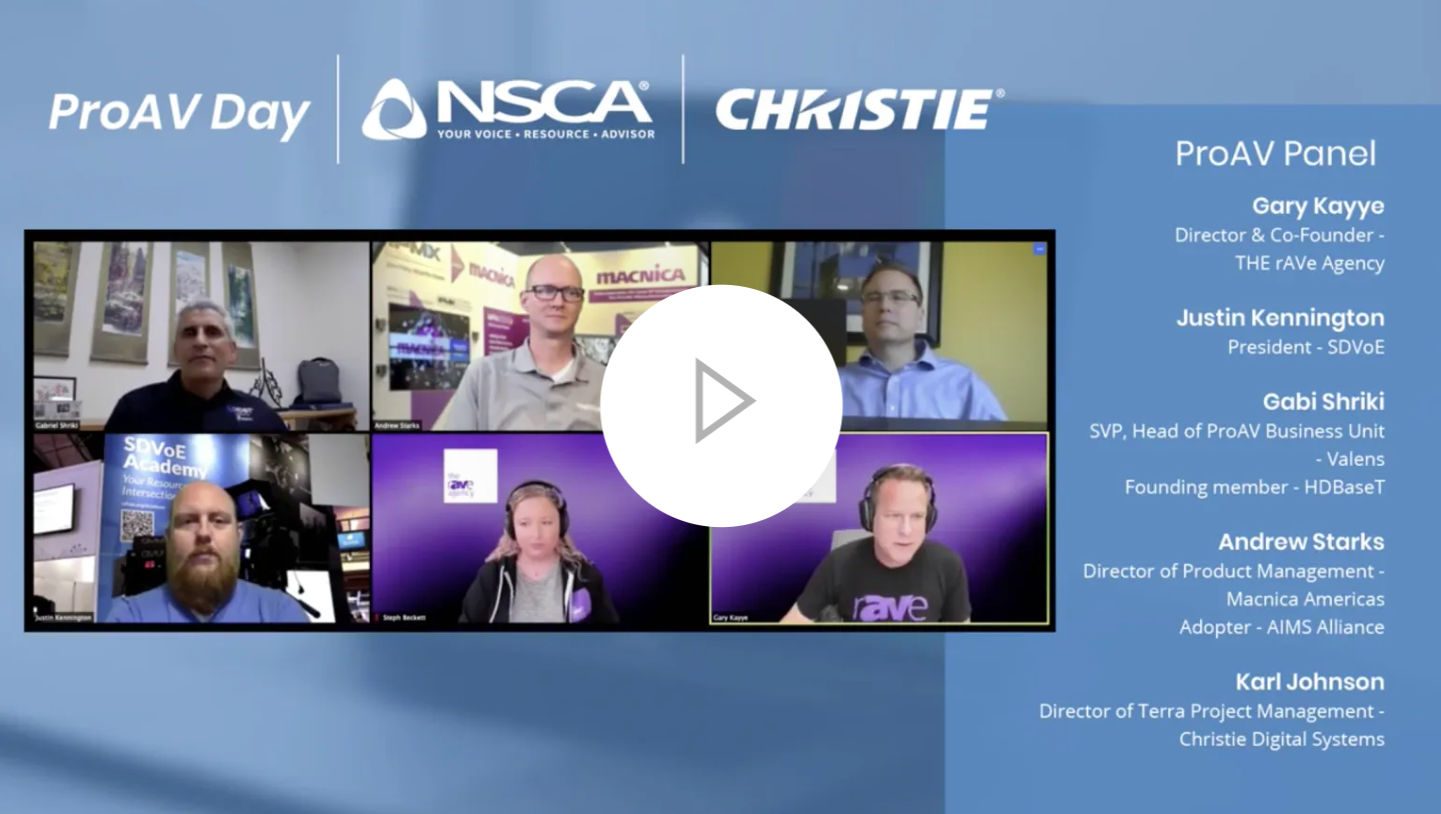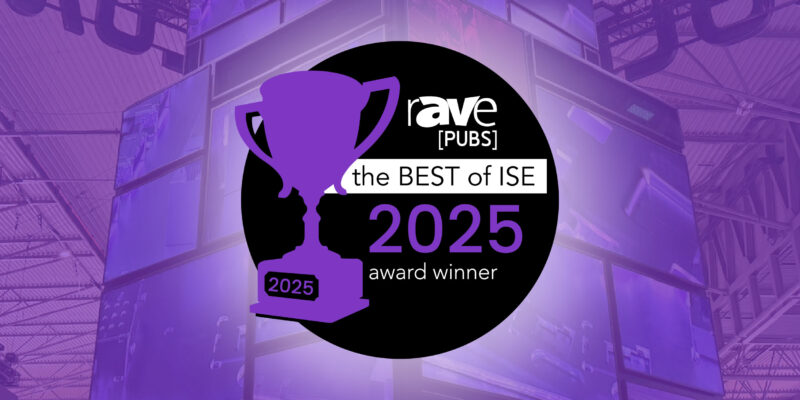The Great AVoIP Debate
I spend some time on Twitter, and yesterday I noticed a lot of online chatter happening around a panel rAVe put together for LAVNCH WEEK 2.0.
Kudos to the staff at rAVe for curating the speakers, because to my knowledge, the people on the panel and the groups they represent had never been assembled together on a panel like this before — and given some of the comments made, perhaps never again, either…
If you missed it, I suggest you log in to the LAVNCH WEEK site above and watch it back like I did in the video archive for ProAV Day.
The panel was moderated by rAVe’s Gary Kayye and included Justin Kennington, president of SDVoE (Software Defined Video over Ethernet); Andrew Starks, director of product management at Macnica Americas and adopter at AIMS Alliance; Gabi Shriki, SVP of the ProAV business unit at Valens (founder of the HDBaseT Alliance); and Karl Johnson, director of Terra project management at Christie Digital.

What was meant to be a debate on the pros and cons of creating a standards-based approach to Video over IP quickly turned into a somewhat heated conversation with each panelist digging their heels in for the specific version of the standard they had a personal stake in. It made for GREAT entertainment and a lot of relevant points came up in the conversation, although I felt like there were some missed opportunities to drive home certain points that were casualties of the crossfire. With that, I wanted to give my take on the highlights and the in between the lines comments that perhaps were not highlighted as they should have been.
Gabi Shriki of Valens did a great job of explaining the digital nature of our signals and of setting up HDBaseT as the first reliable way of combining all of our signals and distributing them in a packet-based way. HDBaseT is the technology that Crestron DM and Valens worked on early on. HDBaseT now has over 200 licensed partners and has permeated ProAV over the last several years. The difference between HDBaseT and Video over IP protocols is that HDBaseT doesn’t use standard ethernet switches to distribute AV signals, they use more of a traditional send/receive/matrix switch environment with RJ45’s and category cables.
I found Gabi to be fair in his assessment of the current landscape, as he explained in a single room, HDBaseT still had many advantages as it didn’t ride (nor need to) on the network. A 3-4 source and single display system, he argued, doesn’t need its signals to be on the corporate network. He went on to say that SDVoE was a great solution for wide area networks where 10G was in place or the cost/benefit could be justified, and that something like the AIMS Alliance’s IPMX may be great for 1G networks where wide distribution of signals across the ether was needed.
So far so good, and then things got a little sketchy. I have an affinity for quality of video so in full disclosure, I have always liked the idea of the SDVoE based systems. I also know Justin Kennington to be very intelligent, and given his background with HDBaseT in its early iteration and now SDVoE, I can’t begin to challenge his technical assessment of the technologies, but I will say that he was the saltiest of the bunch in his commentary. He brought a lot of knowledge, but encoded it in a way that was somewhat sarcastic and dismissive.
That approach brought out the fight in the rest of the panel, so I guess it added the needed spark although with more friction than necessary. Justin did make a point that ended up getting lost in the fray that I think is very important though.
The reason that HDBaseT is still so viable in smaller, individual environments is that it is cost-effective and doesn’t require network access. However, Justin mentioned that Semtech, a chip manufacturer for SDVoE products, was coming out with a very cost-effective product.
The implication here is that the cost differential will be minimized, making the individual room a target for the technology.
Placing SDVoE sources and Syncs in a room would also not necessarily require enterprise network access, as a small 8 port switch could be used in the room as a standalone network, eliminating the need for a traditional HDBaseT matrix switch. This means that HDBaseT could potentially lose a foothold in these types of environments in the future.
The added advantage to building rooms in this way going forward would be that at any given time, these small private networks could be connected, and since SDVoE rides on the network, a connected infrastructure could be created later without a substantial tech refresh or hardware upgrade. The encoders and decoders are ready to go from a private LAN or VLAN to the WAN.
Justin made one other great point that got hidden in a snarky slam, and that was that HDBaseT has not been consistently implemented by all of its partners. Some HDBaseT system leverage all the transport functions while others do not, and even within HDBaseT products, full interoperability is not guaranteed. (Gary Kayye wrote about this in the past as well).
This is where one of Andrew Starks points became very relevant, although the group tried to downplay it. He asked if SDVoE was a standard or a licensing agreement. A standard is enforced and open. A license agreement is pay-for-play and often not open to scrutiny or required to be certified by the licensing body. This is why HDMI cables have varying degrees of functionality and quality, this is why HDBaseT products had varying levels of implementation of the full transport, and this is where SDVoE may have the risk of falling to the same with its 55 partners so far.
Andrew argued that their system had an open API today, and anyone could build in the standard. I’m not arguing that IPMX is the best way to accomplish this, but I am validating the point that Andrew made, that an open standard allows for development in a way that promotes wider interoperability.
Andrew made two other really great points about initiatives that the AIMS alliance has prioritized. The first is the API is as or more important than raw video quality. If you can provide slightly better video but it comes at the cost of a clunky interface or potential miscommunication between devices, then it doesn’t matter. The second, and I felt nearly lost comment that perked my ears up, was that IPMX is working to certify a different version of HDCP more friendly to wide distribution of signals and multicast networks, etc. For anyone battling the key exchanges and management or the hassles of white listing individual projects to open up signal distribution on HDCP 2.0, you know how amazing this could be.
There was a lot of talk about the JPEG and SMPTE protocols of converting between them or creating proprietary versions like Crestron did for NVX and the pros and cons. No real answer emerged as the solution to any of this, although everyone had their own thoughts. The only real point that stuck out to me that I feel like most agreed with, was that all other things being equal, less compression is better than more and you will lose less if you minimize conversion of the signals between formats.
Finally, there was a lot of Q&A and push back from the audience in the Q&A about Dante with regards to it’s AV transport capability. Gary said it was an open channel, Gabi confirmed, but the viewers kept fighting that statement, asserting that Dante Video was its own standard. I’m fairly certain it is indeed an open channel, agnostic to the method of transport, but I took a completely different point away from that sidebar.
Why was the audience so invested or hopeful that Dante would be its own standard?
I would argue that the reason the audience wanted this to be true so badly was because they have had great, consistent experiences with Dante audio and are hoping that Dante will be the one to throw a life-preserver to them as they float in the turbulent sea of video over IP debate this panel was indicative of.
So at the end of the day, this panel really drove home a few things.
- In typical AV fashion, there is no apparent path to an agreed standard yet.
- An open API seems essential to maximum interoperability.
- Products made under licensing agreements could benefit from an independent certification body to assure products are interoperable
- As cost levels out, viability of VoIP systems on standalone networks will equal that of HDBaseT for small room environments.
- An alternate HDCP arrangement for commercial AV distribution over the network would be an amazing thing.
- Less compression and conversion should be a long term goal for maximizing video quality.
I still encourage you to watch the panel. It was a good show, and you may just find some Easter eggs that I missed.





